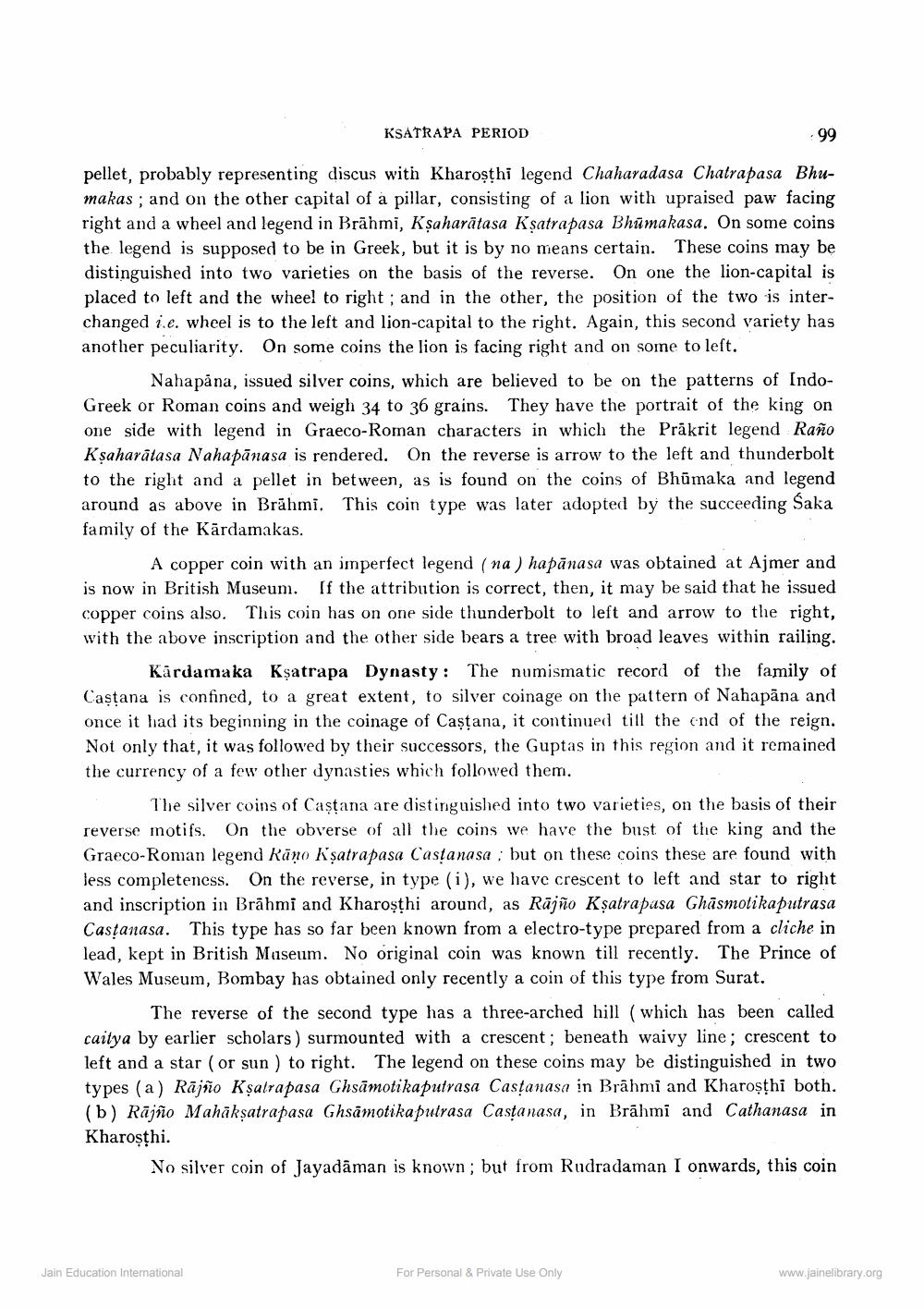________________
KSATRAPA PERIOD
99
pellet, probably representing discus with Kharoșthi legend Chaharadasa Chatrapasa Bhumakas; and on the other capital of a pillar, consisting of a lion with upraised paw facing right and a wheel and legend in Brāhmi, Kșaharātasa Kșatrapasa Bhūmakasa. On some coins the legend is supposed to be in Greek, but it is by no means certain. These coins may be distinguished into two varieties on the basis of the reverse. On one the lion-capital is placed to left and the wheel to right; and in the other, the position of the two is interchanged i.e. wheel is to the left and lion-capital to the right. Again, this second variety has another peculiarity. On some coins the lion is facing right and on some to left.
Nahapāna, issued silver coins, which are believed to be on the patterns of IndoGreek or Roman coins and weigh 34 to 36 grains. They have the portrait of the king on one side with legend in Graeco-Roman characters in which the Prakrit legend Raño Ksaharătasa Nahapānasa is rendered. On the reverse is arrow to the left and thunderbolt to the right and a pellet in between, as is found on the coins of Bhūmaka and legend around as above in Brāhmi. This coin type was later adopted by the succeeding Saka family of the Kārdamakas.
A copper coin with an imperfect legend (na) hapānasa was obtained at Ajmer and is now in British Museum. If the attribution is correct, then, it may be said that he issued copper coins also. This coin has on one side thunderbolt to left and arrow to the right, with the above inscription and the other side bears a tree with broad leaves within railing.
Kārdamaka Kşatrapa Dynasty: The numismatic record of the family of Castana is confined, to a great extent, to silver coinage on the pattern of Nahapāna and once it had its beginning in the coinage of Castana, it continued till the end of the reign. Not only that, it was followed by their successors, the Guptas in this region and it remained the currency of a few other dynasties which followed them.
The silver coins of Castana are distinguished into two varieties, on the basis of their reverse motifs. On the obverse of all the coins we have the bust of the king and the Graeco-Roman legend Rāno K'șatrapasa Castanasa ; but on these coins these are found with less completeness. On the reverse, in type (i), we have crescent to left and star to right and inscription in Brāhmi and Kharoşthi around, as Rājño Kșatrapasa Ghāsmotikaputrasa Castanasa. This type has so far been known from a electro-type prepared from a cliche in lead, kept in British Maseum. No original coin was known till recently. The Prince of Wales Museum, Bombay has obtained only recently a coin of this type from Surat.
The reverse of the second type has a three-arched hill (which has been called caitya by earlier scholars) surmounted with a crescent; beneath waivy line; crescent to left and a star (or sun ) to right. The legend on these coins may be distinguished in two types (a) Rājño Kșatrapasa Ghsāmotikaputrasa Casțanasa in Brāhmi and Kharoşthi both. (b) Rājño Mahaksatrapasa Ghsamotikaputrasa Castanasa, in Brāhmi and Cathanasa in Kharoșthi.
No silver coin of Jayadāman is known; but from Rudradaman I onwards, this coin
Jain Education Intemational
For Personal & Private Use Only
www.jainelibrary.org




